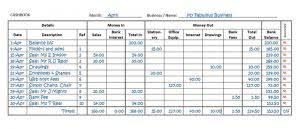
As we draw this guide to a close, it’s clear that the double-declining balance method is a powerful tool for managing asset depreciation. It offers businesses the agility to maximize tax benefits early on while aligning depreciation expenses with the actual decline in asset value. However, its complexity and the potential for future financial implications mean it’s not a one-size-fits-all solution. Selecting the right depreciation method is a strategic decision that requires an in-depth understanding of both your company’s assets and its financial goals. For assets like advanced technology devices or equipment susceptible to becoming obsolete quickly, the double declining balance method is particularly advantageous because it accounts for their swift loss in value.

How to Journalize the Double-Declining Balance Method
These financial relationships support our content but do not dictate our recommendations. Our editorial team independently evaluates products based on thousands of hours of research. Businesses double-declining-balance depreciation choose to use the Double Declining Balance Method when they want to accurately reflect the asset’s wear and tear pattern over time.
Key Formulas Involved
Both methods reduce depreciation expense over time, but DDB Bakery Accounting does so more rapidly. Explore the nuances of double declining balance depreciation, its calculation, and how it compares to other methods. Companies will typically keep two sets of books (two sets of financial statements) – one for tax filings, and one for investors.
Example 2: Depreciation of Machinery with Variable Lifespan
Depreciation is a crucial concept in business accounting, representing the gradual loss of value in an asset over time. Among the various methods of calculating depreciation, the Double Declining Balance (DDB) method stands out for its unique approach. This article is a must-read for anyone looking to understand and effectively apply the DDB method.
- The double declining balance method enhances the process of calculating depreciation by amplifying the straight-line depreciation rate—simply the inverse of an asset’s useful life.
- The benefit of using an accelerated depreciation method like the double declining balance is two-fold.
- Adhering to standards like Generally Accepted Accounting Principles (GAAP) or International Financial Reporting Standards (IFRS) is critical for consistency and transparency.
- Likewise, the depreciation rate in declining balance depreciation will be 40% (20% x 2).
- The beginning of period (BoP) book value of the PP&E for Year 1 is linked to our purchase cost cell, i.e.
- In my experience, using the double declining balance method can help businesses manage their taxes effectively by allowing them to report lower profits in the early years of an asset’s life.
Method 6 – Applying Units of Production Formula of Depreciation for Declining Balance
- The declining balance method of Depreciation is also called the reducing balance method, where assets are depreciated at a higher rate in the initial years than in the subsequent years.
- Business News Daily provides resources, advice and product reviews to drive business growth.
- This approach assumes that all acquisitions and disposals occur midway through the fiscal year, allowing for half a year’s worth of depreciation to be recorded in the year of purchase.
- Next year when you do your calculations, the book value of the ice cream truck will be $18,000.
- The following section explains the step-by-step process for calculating the depreciation expense in the first year, mid-years, and the asset’s final year.
- Depreciation is a complicated business and I hope my tutorials give you a good grasp as to how assets are expensed in the accounting system.
Essentially, this simply means that you use the straight-line method for the remainder of the asset’s useful life. The double declining balance method of depreciation, also known as the 200% declining balance method of depreciation, is a form of accelerated depreciation. This means that compared to the straight-line method, the depreciation expense will be faster in the early years of the asset’s life but slower in the later years. However, the total amount of depreciation expense during the life of the assets will be the same.
Its complex computations may prove more challenging than the straight-line method’s straightforward approach, raising the possibility of mistakes and added complexity. Due to fluctuations in annual deductions with this approach, forecasting profits can become unpredictable. Depreciation rates between the two methods of calculating depreciation are similar except that the DDD Rate is twice the value of the SLD rate. In the depreciation of the asset for each period, the salvage value is not considered when doing calculations for DDD balance. It doesn’t always use assets’ salvage value (or residual value) while computing the depreciation.

How to Calculate Declining Balance Depreciation
It allows users to extract and ingest data automatically, and use formulas on the data to process and transform it. Using the steps outlined above, let’s walk through an example of how to build a table that calculates the full depreciation schedule over the life of the asset. We’ve pinpointed the 8 most common financial challenges that small business owners face. With our expert insights, you’ll not only recognize these pitfalls but also learn practical strategies to overcome them. Empower yourself with the knowledge to master tax season and fortify your financial future.

Why is double declining depreciation an accelerated method?
Since public companies are incentivized to increase shareholder value (and thus, their share price), it is often in their best interests to recognize depreciation more gradually using online bookkeeping the straight-line method. However, one counterargument is that it often takes time for companies to utilize the full capacity of an asset until some time has passed. Business News Daily provides resources, advice and product reviews to drive business growth. Our mission is to equip business owners with the knowledge and confidence to make informed decisions.
Leave a Reply